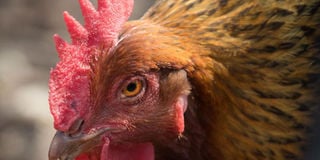Prime
How to control bird flu in poultry

The symptoms of bird flu may include poor respiratory symptoms, behavioural changes and diminishing egg production, among others
What you need to know:
The symptoms of bird flu may include poor respiratory symptoms, behavioural changes and diminishing egg production, among others, writes Christine Katende.
One of the major problems poultry farmers face is bird flu (Avian Influenza or HPAI H5).
This is a viral disease that affects wild birds, captive wild birds and domestic poultry (including backyard chickens, according to Dr Samuel Nsubuga, a veterinary doctor affiliated to Smart Agribusiness Forum Africa.
Bird flu if not attended to immediately can sweep the whole farm.
However, there are two forms of avian influenza, that is low pathogenicity (LPAI) and high pathogenicity (HPAI). Of the two, the most common one is low pathogenicity avian influenza. Nsubuga says it is mostly harmless and the infected chickens will react with general flu/cold-like symptoms.
On the other hand, highly pathogenicity avian influenza is extremely contagious and kills approximately 90 per cent of all birds that catch the disease.
How it is spread
According to the veterinary doctor, birds contract the virus via contact with nasal secretions or faeces from an infected bird. The virus can also spread through poor ventilation in the poultry house, lack of knowledge about bird management, wild birds that enter bird houses, unclean houses and from clothing of people who visit the bird houses as well as sharing of equipment and shelter between infected and non-infected birds.
Symptoms
There are different ways bird flu can present itself, according Nsubuga. It however, calls for farmers to always be keen, so as to take immediate action.
Birds and poultry with bird flu may exhibit respiratory symptoms such as coughing and wheezing. There may also be nasal discharge, in some cases tinged with blood, according to the vet.
Birds with avian influenza often behave differently from before they became infected. For example, they may seem depressed or be inactive. They tend to eat and drink less than normally. The expert adds that the birds may also suddenly become unable to stand or walk normally.
If they have started laying eggs the time they get infected, the birds often produce fewer eggs than before. In addition, the egg shells also tend to be too soft or shapeless.
Physical signs
Among the physical signs, ,Nsubuga says, a farmer has to take note of are; ruffling of the feathers, the colour of the combs and waddles on the birds turning to bluish-purple and the combs, waddles, hocks, eyelids and head will get swollen.
Diarrhoea may develop in some birds with avian influenza as well as sudden death without any signs.
Treatment
Although the virus is very contagious, Nsubuga says it can be treated as long as the farmer identifies the situation quickly. The treatment for the virus include antiviral medication. However, he advises that the treatment be carried out by a professional veterinary personnel.
“Farmers should avoid trials and testing of treatment doses they are not sure of, as these can result in killing of birds or even misuse of drugs and vaccines,” he cautions.
Dr Nsubuga says there are helpful herbs a farmer can apply as treatment.
Aloevera, which is locally known as kigaji. is applied by chopping the leaves into pieces and putting them in drinking water.
Red pepper is also used by crushing the friuts and infusing into drinking water. This concoction targets their breath problems and respiratory symptoms. However, some of the control measures which Dr Nsubuga suggests include; Vaccinating uninfected birds to render the virus harmless. Vaccination also improves immunity and body defence towards influenza virus. But in this case, a farmer has to vaccinate the birds before cases break out.
Separation of the infected birds from the healthy ones is also useful, according to Dr Nsubuga. “But what you should know is that once a chicken catches highly pathogenicity avian influenza, it will be dead within an hour,” he cautions.




